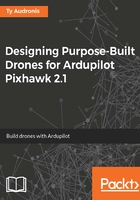
3D modeling, printing, and silicone molding
One of the best materials to construct a mounting platform for a Pixhawk from is Gel-10 silicone. It's the same stuff they use to make skin-like objects for masks, detached limbs for visual effects in movies, and, well, many other skin-like products. It's flexible, soft, and easily moulded. You could also make platforms from soft foam if you don't have access to these tools. We're not actually going to make this particular platform from silicone though. Why? Because the tray is too deep. The silicone would be too tall, and it would bounce around like gelatine. We're going to use a 3D-printed part. However, so that you can learn the process of mould-making, we'll make one out of silicone. The mould will be useful still, because if we crash the rover and destroy the mount, who wants to wait 3 hours for another print out? We could just use our mould and pour some two-part plastic into it. Let's give you a quick primer in making custom parts.